2. More mothers did not stay at home because of the recession
The economic downturn had little effect on women’s employment. In 2009, the employment rate for 20 to 59-year-old mothers was about 76 per cent, which was two percentage points lower than in the previous year. The employment rate for women without children in the same age group stayed at 78 per cent. Unlike with men, the difference between the employment rates for women without children and for mothers was thus very small.
In recent years, employment rates have been very similar from one year to the next for women without children and for mothers. (Figure 3.)
Figure 3. Employment rates for 20 to 59-year-old mothers and women without children in 2004–2009
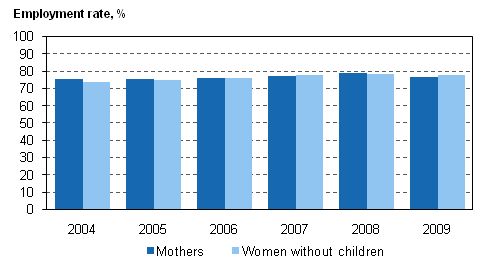
The age of the youngest child has a clear impact on the mothers’ employment (Figure 4). Only about one-half of mothers are employed if their youngest child is aged under three. Mothers’ employment rate rises to 90 per cent or so, i.e. same level as fathers’, only once the youngest child has reached school age. Fathers’ employment rate, in turn, remains equally high irrespective of the age of his children. This means that mothers still continue to take most of the long family leaves.
Figure 4. Employment rate for 20 to 59-year-old mothers by age of youngest child in 2004–2009
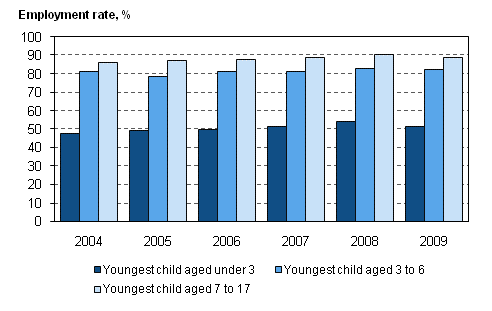
2.1 Mothers’ use of family leaves has remained unchanged
The employment rate alone does not reveal the proportion of the parents of young children who actually work. Persons on maternity or paternity leave from work as well as persons whose absence from work has lasted under three months are classified as employed in the Labour Force Survey. Thus, especially in the case of mothers of very small children the employed include a lot of mothers who are actually at home looking after a child. Respectively, mothers on child care leave are mostly classified as persons outside the labour force even if they have a valid employment contract because the child care leave is often taken immediately after the maternity leave and parental leave, which lengthens the total duration of the leave.
Figure 5 shows as a separate group those mothers of under three-year-old children who actually go to work. It also describes separately the mothers on family leave (maternity, parental or child care leave) from a valid employment contract and the mothers without a valid employment contract who are looking after their children at home. The category of other non-employed persons includes e.g. students or unemployed persons.
Figure 5. Working and family leaves of 20 to 59-year-old mothers with children aged under three in 2008–2009
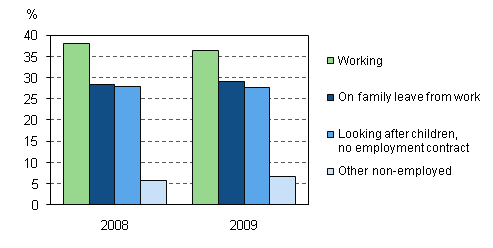
The results obtained by examining the working of mothers this way are very similar to the results reported above from the examination of employment rates. The economic downturn that started at the turn of 2008/2009 does not seem to be reflected in the working of mothers of small children so that more of them would have decided to stay at home to look after their children. The shares of mothers on family leave or without a valid employment contract and caring for their children among all mothers of children aged under three were almost the same in 2009 and 2008 (Figure 5).
When the mothers on family leaves are separated from those working, in reality only about one-third of the mothers of under three-year-olds were working in 2009. However, the groups of mothers of under one-year-olds and mothers of one to two-year-olds are very different (Figure 6). Of the mothers whose youngest child was aged under one, fewer than nine per cent were working, over one-half were on a family leave and good one-third were at home caring for the child and did not have a valid employment contract. When the youngest child was aged between one and two, as many as over one-half of the mothers were working. Thus, the share of mothers who work rises fast as the youngest child grows older because the mothers either return to work from family leave or find employment.
Figure 6. Working and family leaves among 20 to 59-year-old mothers by age of youngest child in 2009
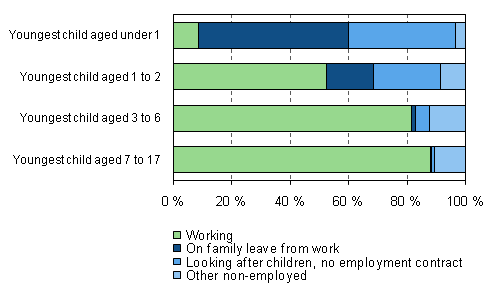
Fathers usually take shorter family leaves than mothers. During the paternity leave, the “daddy” month or the child care leave lasting under three months fathers are classified as employed so family leaves have little impact on the employment rate of fathers. However, the picture of the employment of fathers hardly changes when the fathers on family leave are separated from the fathers who are working, because only two per cent of the fathers of under three-year-olds were on a family leave during the survey week in 2009.
2.2 More mothers stay at home after the arrival of third child
Apart from the age of children, their number also influences the employment of mothers (Figure 7). In 2009, 82 per cent of the mothers of two children were employed but only 65 per cent of mothers were still employed if there were at least three children. The number of children has no impact on the employment of fathers.
Figure 7. Employment rates of fathers and mothers aged 20 to 59 by number of children in 2009
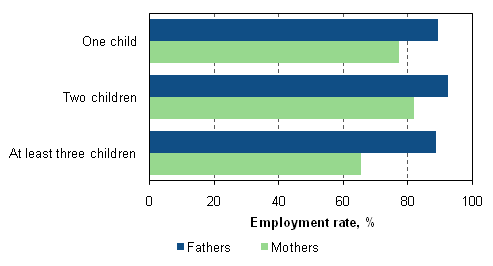
Indeed, staying at home is clearly more usual for the mothers of families with three or more children than among the mothers of families with one or two children. One in five of the mothers of families with at least three children were looking after the children at home and had no valid employment contract in 2009 (Figure 8). Working and looking after children were nearly equally common among the mothers of one child or two children. The groups differed slightly only because the mothers of one child are more often outside working life for some other reason, such as studying.
Figure 8. Working and family leaves among 20 to 59-year-old mothers by number of children in 2009
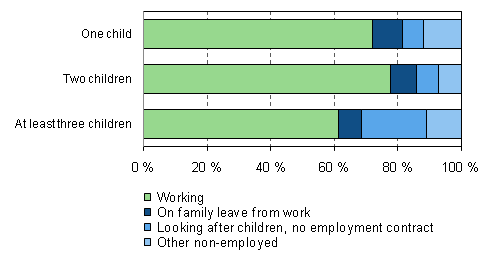
Source: Labour force survey 2009. Statistics Finland
Inquiries: Laura Hulkko (09) 1734 2611, Anna Pšrnšnen (09) 1734 2607, tyovoimatutkimus@stat.fi
Director in charge: Riitta Harala
Updated 12.10.2010
Official Statistics of Finland (OSF):
Labour force survey [e-publication].
ISSN=1798-7857. 16 2009,
2. More mothers did not stay at home because of the recession
. Helsinki: Statistics Finland [referred: 13.1.2026].
Access method: http://stat.fi/til/tyti/2009/16/tyti_2009_16_2010-10-12_kat_002_en.html

